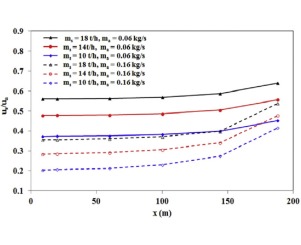Particuology ( IF 4.1 ) Pub Date : 2017-05-09 , DOI: 10.1016/j.partic.2016.11.006 Baldeep Kaur , Anu Mittal , S.S. Mallick , Renhu Pan , Soumendu Jana

|
Accurate prediction of the solids friction factor through horizontal straight pipes is important for the reliable design of a pneumatic conveying system, but it is a challenging assignment to date because of the highly concentrated, turbulent, and complex nature of the gas–solids mixture. Power-station fly ash was transported through different pipeline configurations. Numerical simulation of the dense-phase pneumatic conveying systems for three different solids and two different air flow rates have shown that particle and actual gas velocities and the ratio of the two velocities increases in the flow direction, whereas the reverse trend was found to occur for the solids volumetric concentration. To develop a solids friction-factor model suitable for dense-phase flow, we modified an existing pure dilute-phase model by incorporating sub-models for particle and actual gas velocities and impact and solids friction factor. The solids friction-factor model was validated by using it for scale-up predictions for total pipeline pressure drops in longer and larger pipes and by comparing experimental and predicted pneumatic conveying characteristics for different solids flow rates. The accuracy of the prediction was compared with a recently developed two-layer-based model. We discussed the effect of incorporating the particle and actual gas velocity terms in the solids friction-factor model instead of superficial air velocity.
中文翻译:

粉末流化密相气力输送数值模拟以建立改进的固体摩擦系数模型
通过水平直管准确预测固体摩擦因数对于气动输送系统的可靠设计很重要,但由于气固混合物的高度浓缩,湍流和复杂性,迄今为止这是一个具有挑战性的任务。发电厂的粉煤灰通过不同的管道配置进行运输。对三种不同固体和两种不同空气流量的密相气力输送系统的数值模拟表明,颗粒和实际气体的速度以及两种速度的比率在流动方向上增加,而发现了相反的趋势。固体体积浓度。要开发适用于密相流的固体摩擦因子模型,我们通过合并子模型来修改现有的纯稀相模型,该模型包含颗粒和实际气体速度以及冲击和固体摩擦系数。通过将固体摩擦因子模型用于按比例放大的预测来预测较长和较大管道中的总管道压降,并通过比较不同固体流速下的实验和预测的气动输送特性,对固体摩擦因子模型进行了验证。将预测的准确性与最近开发的基于两层的模型进行了比较。我们讨论了将颗粒和实际气体速度项并入固体摩擦因子模型而不是表面空气速度的影响。通过将固体摩擦因子模型用于按比例放大的预测来预测较长和较大管道中的总管道压降,并通过比较不同固体流速下的实验和预测的气动输送特性,对固体摩擦因子模型进行了验证。将预测的准确性与最近开发的基于两层的模型进行了比较。我们讨论了将颗粒和实际气体速度项并入固体摩擦因子模型而不是表面空气速度的影响。通过将固体摩擦因子模型用于按比例放大的预测来预测较长和较大管道中的总管道压降,并通过比较不同固体流速下的实验和预测的气动输送特性,对固体摩擦因子模型进行了验证。将预测的准确性与最近开发的基于两层的模型进行了比较。我们讨论了将颗粒和实际气体速度项并入固体摩擦因子模型而不是表面空气速度的影响。











































 京公网安备 11010802027423号
京公网安备 11010802027423号